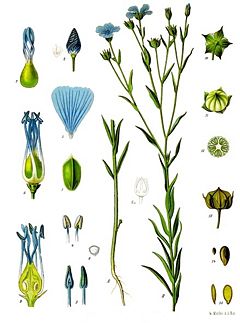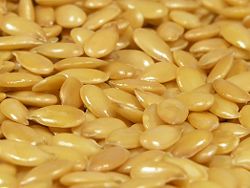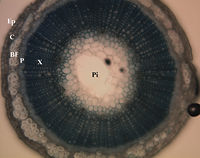Flax
| Flax | ||||||||||||||
|---|---|---|---|---|---|---|---|---|---|---|---|---|---|---|
 The flax plant
|
||||||||||||||
| Scientific classification | ||||||||||||||
|
||||||||||||||
| Binomial name | ||||||||||||||
| Linum usitatissimum Linnaeus. |
Flax (also known as common flax or linseed) (binomial name: Linum usitatissimum) is a member of the genus Linum in the family Linaceae. It is native to the region extending from the eastern Mediterranean to India and was probably first domesticated in the Fertile Crescent This is called as Jawas/Javas or Alashi in Marathi.[1] Flax was extensively cultivated in ancient Egypt. (New Zealand flax is not related to flax, but was named after it as both plants are used to produce fibres.)
Flax is an erect annual plant growing to 1.2 m tall, with slender stems. The leaves are glaucous green, slender lanceolate, 20–40 mm long and 3 mm broad. The flowers are pure pale blue, 15–25 mm diameter, with five petals; they can also be bright red. The fruit is a round, dry capsule 5–9 mm diameter, containing several glossy brown seeds shaped like an apple pip, 4–7 mm long.
In addition to referring to the plant itself, "flax" may refer to the unspun fibres of the flax plant.
Contents |
Uses
Flax is grown both for its seeds and for its fibers. Various parts of the plant have been used to make fabric, dye, paper, medicines, fishing nets and soap. It is also grown as an ornamental plant in gardens.
Flax seed

| Flax seed Nutritional value per 100 g (3.5 oz) |
||||||||||||||||||||||||||||||||||||
|---|---|---|---|---|---|---|---|---|---|---|---|---|---|---|---|---|---|---|---|---|---|---|---|---|---|---|---|---|---|---|---|---|---|---|---|---|
| Energy 530 kcal 2230 kJ | ||||||||||||||||||||||||||||||||||||
|
||||||||||||||||||||||||||||||||||||
| Percentages are relative to US recommendations for adults. Source: USDA Nutrient database |
||||||||||||||||||||||||||||||||||||
Flax seeds come in two basic varieties, brown and yellow or golden, with most types having similar nutritional values and equal amounts of short-chain omega-3 fatty acids. The exception is a type of yellow flax called Linola or solin, which has a completely different oil profile and is very low in omega-3. Although brown flax can be consumed as readily as yellow, and has been for thousands of years, it is better known as an ingredient in paints, fiber and cattle feed. Flax seeds produce a vegetable oil known as flaxseed or linseed oil; it is one of the oldest commercial oils and solvent-processed flax seed oil has been used for centuries as a drying oil in painting and varnishing.
One hundred grams of ground flax seed supplies about 450 kilo-calories, 41 grams of fat, 28 grams of fiber, and 20 grams of protein.[2]
One tablespoon of ground flax seeds and three tablespoons of water may serve as a replacement for one egg in baking by binding the other ingredients together. Ground flax seeds can also be mixed in with oatmeal, yogurt, water (similar to Metamucil), or any other food item where a nutty flavour is appropriate. Flax seed sprouts are edible, with a slightly spicy flavour. Excessive consumption of flax seeds can cause diarrhea.[3]
Flax seeds are chemically stable while whole, and milled flaxseed can be stored at least 4 months at room temperature with minimal or no changes in taste, smell, or chemical markers of rancidity.[4] Ground flaxseed can go rancid at room temperature in as little as one week.[5] Refrigeration and storage in sealed containers will keep ground flax from becoming rancid for even longer.
Possible medical benefits
Flax seeds contain high levels of lignans and Omega-3 fatty acids. Lignans may benefit the heart, possess anti-cancer properties and studies performed on mice found reduced growth in specific types of tumors. Initial studies suggest that flaxseed taken in the diet may benefit individuals with certain types of breast[6][7] and prostate cancers.[8] Flax may also lessen the severity of diabetes by stabilizing blood-sugar levels.[9] There is some support for the use of flax seed as a laxative due to its dietary fiber content[3] though excessive consumption without liquid can result in intestinal blockage.[10] Consuming large amounts of flax seed can impair the effectiveness of certain oral medications, due to its fiber content.[10]
Raw flax seed contains the chemical hydrogen cyanide (HCN) or cyanogenic glucosides which can be toxic if consumed in large quantities.[11]
Flax fibers
Flax fibers are amongst the oldest fiber crops in the world. The use of flax for the production of linen goes back 5000 years. Pictures on tombs and temple walls at Thebes depict flowering flax plants. The use of flax fibre in the manufacturing of cloth in northern Europe dates back to Neolithic times. In North America, flax was introduced by the Puritans. Currently most flax produced in the USA and Canada are seed flax types for the production of linseed oil or flaxseeds for human nutrition.
Flax fiber is extracted from the bast or skin of the stem of the flax plant. Flax fiber is soft, lustrous and flexible. It is stronger than cotton fiber but less elastic. The best grades are used for linen fabrics such as damasks, lace and sheeting. Coarser grades are used for the manufacturing of twine and rope. Flax fiber is also a raw material for the high-quality paper industry for the use of printed banknotes and rolling paper for cigarettes. Flax mills for spinning flaxen yarn were invented by John Kendrew and Thomas Porthouse of Darlington in 1787.[12]
Cultivation
The linseed producing countries are Canada(~34%), China(~25.5%) and India(~9%), though there is also significant production in USA(~8%), Ethiopia(~3.5%) and throughout Europe. In the United States, three states, North Dakota, South Dakota, and Minnesota, raise nearly 100% of this plant.
| Top Ten Linseed Producers — 2007 | ||||
|---|---|---|---|---|
| Country | Production (Tonnes) | Footnote | ||
| 633,500 | ||||
| 480,000 | * | |||
| 167,000 | ||||
| 149,963 | ||||
| 67,000 | * | |||
| 50,000 | F | |||
| 47,490 | ||||
| 45,000 | * | |||
| 41,000 | F | |||
| 34,000 | ||||
| 1875,018 | A | |||
| No symbol = official figure, P = official figure, F = FAO estimate, * = Unofficial/Semi-official/mirror data, C = Calculated figure A = Aggregate(may include official, semi-official or estimates); |
||||
The soils most suitable for flax, besides the alluvial kind, are deep friable loams, and containing a large proportion of organic matter. Heavy clays are unsuitable, as are soils of a gravelly or dry sandy nature. Farming flax requires few fertilizers or pesticides. Within six weeks of sowing, the plant will reach 10-15 cm in height, and will grow several centimeters per day under its optimal growth conditions, reaching 70-80 cm within fifteen days.
Diseases
Maturation
Flax is harvested for fiber production after approximately 100 days, a month after the plant flowers and two weeks after the seed capsules form. The base of the plant will begin to turn yellow; if the plant is still green the seed will not be useful, and the fiber will be underdeveloped. The fiber degrades once the plant is brown.
Harvesting Methods
There are two ways to harvest flax, one involving mechanized equipment (combines), and a second method, more manual and targeted towards maximizing the fiber length.
Method 1
The mature plant is cut with mowing equipment, similar to hay harvesting, and raked into windrows. When dried sufficiently, a combine then harvests the seeds similar to wheat or oat harvesting. The amount of weeds in the straw affects its marketability, and this coupled with market prices determined whether the farmer chose to harvest the flax straw. If the flax was not harvested, it was typically burnt, since the straw stalk is quite tough and decomposes slowly (i.e., not in a single season), and still being somewhat in a windrow from the harvesting process, the straw would often clog up tillage and planting equipment. It was common, in the flax growing regions of western Minnesota, to see the harvested flax straw (square) bale stacks start appearing every July, the size of some stacks being estimated at 10-15 yards wides by 50 or more yards long, and as tall as a two-story house.
Method 2
The mature plant is pulled up with the roots (not cut), so as to maximize the fiber length. After this the flax is allowed to dry, the seeds are removed, and is then retted. Dependent upon climatic conditions, characteristics of the sown flax and fields, the flax remains in the ground between 2 weeks and 2 months for retting. As a result of alternating rain and the sun, an enzymatic action degrades the pectins which bind fibers to the straw. The farmers turn over the straw during retting to evenly rett the stalks. When the straw is retted and sufficiently dry, it is rolled up. It will then be stored by farmers before scutching to extract fibers.
Flax grown for seed is allowed to mature until the seed capsules are yellow and just starting to split; it is then harvested by combine harvester and dried to extract the seed.
Threshing flax

Threshing is the process of removing the seeds from the rest of the plant. As noted above in the "Method 1" Harvesting Methods section, the threshing could be done in the field by a machine, or in another process, a description of which follows:
The process is divided into two parts: the first part is intended for the farmer, or flax-grower, to bring the flax into a fit state for general or common purposes. This is performed by three machines: one for threshing out the seed, one for breaking and separating the straw (stem) from the fibre, and one for further separating the broken straw and matter from the fibre. In some cases the farmers thrash out the seed in their own mill and therefore, in such cases, the first machine will be unnecessary.
The second part of the process is intended for the manufacturer to bring the flax into a state for the very finest purposes, such as lace, cambric, damask, and very fine linen. This second part is performed by the refining machine only.
The threshing process would be conducted as follows:hanjad
- Take the flax in small bundles, as it comes from the field or stack, and holding it in the left hand, put the seed end between the threshing machine and the bed or block against which the machine is to strike; then take the handle of the machine in the right hand, and move the machine backward and forward, to strike on the flax, until the seed is all threshed out.
- Take the flax in small handfuls in the left hand, spread it flat between the third and little finger, with the seed end downwards, and the root-end above, as near the hand as possible.
- Put the handful between the beater of the breaking machine, and beat it gently till the three or four inches, which have been under the operation of the machine, appear to be soft.
- Remove the flax a little higher in the hand, so as to let the soft part of the flax rest upon the little finger, and continue to beat it till all is soft, and the wood is separated from the fibre, keeping the left hand close to the block and the flax as flat upon the block as possible.
- The other end of the flax is then to be turned, and the end which has been beaten is to be wrapped round the little finger, the root end flat, and beaten in the machine till the wood is separated, exactly in the same way as the other end was beaten.
Preparation for spinning

Before the flax fibers can be spun into linen, they must be separated from the rest of the stalk. The first step in this process is called retting. Retting is the process of rotting away the inner stalk, leaving the outer fibres intact. At this point there is still straw, or coarse fibers, remaining. To remove these the flax is "broken", the straw is broken up into small, short bits, while the actual fiber is left unharmed, then "scutched", where the straw is scraped away from the fiber, and then pulled through "hackles", which act like combs and comb the straw out of the fiber.
Retting flax
There are several methods of retting flax. It can be retted in a pond, stream, field or a tank. When the retting is complete the bundles of flax feel soft and slimy, and quite a few fibres are standing out from the stalks. When wrapped around a finger the inner woody part springs away from the fibres.
Pond retting is the fastest. It consists of placing the flax in a pool of water which will not evaporate. It generally takes place in a shallow pool which will warm up dramatically in the sun; the process may take from only a couple days to a couple weeks. Pond retted flax is traditionally considered lower quality, possibly because the product can become dirty, and easily over-retts, damaging the fiber. This form of retting also produces quite an odor.
Stream retting is similar to pool retting, but the flax is submerged in bundles in a stream or river. This generally takes longer than pond retting, normally by two or three weeks, but the end product is less likely to be dirty, does not stink as much, and because the water is cooler it is less likely to be over-retted.
Both Pond and Stream retting were traditionally used less because they pollute the waters used for that process.
Field retting is laying the flax out in a large field, and allowing dew to collect on it. This process normally takes a month or more, but is generally considered to provide the highest quality flax fibers, and produces the least pollution.
Retting can also be done in a plastic trash can or any type of water tight container of wood, concrete, earthenware or plastic. Metal containers will not work, as an acid is produced when retting, and it would corrode the metal. If the water temperature is kept at 80 °F, the retting process under these conditions takes 4 or 5 days. If the water is any colder it takes longer. Scum will collect at the top and an odour is given off like in pond retting.Now enzymatic retting of flax is widely employed.
Dressing the flax
Dressing the flax is the term given to removing the straw from the fibers. Dressing consists of three steps: breaking, scutching, and heckling. The breaking breaks up the straw, then some of the straw is scraped from the fibers in the scutching process, then the fiber is pulled through heckles to remove the last bits of straw.
The dressing is done as follows:
- Breaking The process of breaking breaks up the straw into short segments. To do it, take the bundles of flax and untie them. Next, in small handfuls, put it between the beater of the breaking machine (a set of wooden blades that mesh together when the upper jaw is lowered, which look like a paper cutter but instead of having a big knife it has a blunt arm), and beat it till the three or four inches that have been beaten appear to be soft. Move the flax a little higher and continue to beat it till all is soft, and the wood is separated from the fiber. When half of the flax is broken, hold the beaten end and beat the rest in the same way as the other end was beaten, till the wood is separated.
- Scutching In order to remove some of the straw from the fiber, it helps to swing a wooden scutching knife down the fibers while they hang vertically, thus scraping the edge of the knife along the fibers and pull away pieces of the stalk. Some of the fiber will also be scutched away, this cannot be helped and is a normal part of the process.
- Heckles In this process the fiber is pulled through various different sized Heckling comb. A heckle is a bed of "nails"- sharp, long-tapered, tempered, polished steel pins driven into wooden blocks at regular spacing. A good progression is from 4 pins per square inch, to 12, to 25 to 48 to 80. The first three will remove the straw, and the last two will split and polish the fibers. Some of the finer stuff that comes off in the last hackles is called "tow" and can be carded like wool and spun. It will produce a coarser yarn than the fibers pulled through the heckles because it will still have some straw in it.
Flax as a symbolic image

- Common flax is the national flower of Belarus.
- Flax is the emblem of the Northern Ireland Assembly.
- The flax plant, in a coronet, appeared on the reverse of the British one pound coin to represent Northern Ireland on coins minted in 1986 and 1991.
Flax in popular culture
- In English, blond hair is traditionally referred to as "fair" or "flaxen". The expression "tow-headed" is used to describe a person with blond hair, comes from the name for the fine, oft-tangled fibers left behind in the hackles, when processing flax into linen.
- The Sleeping Beauty tales seem to have a common origin with flax - in nearly every version of the tale, the Sleeping Beauty is poked by a sliver of flax.
See also
|
|
Notes
- ↑ Alister D. Muir, Neil D. Westcot, ""Flax: The Genus Linum""., page 3 (August 1 2003).
- ↑ "Flax nutrition profile". Retrieved on 2008-04-24.
- ↑ 3.0 3.1 Mayo Clinic (2006-05-01). "Drugs and Supplements: Flaxseed and flaxseed oil (Linum usitatissimum)". Retrieved on 2007-07-02.
- ↑ Malcolmson, L.J. (2006-04). "Storage stability of milled flaxseed". Retrieved on 2008-04-24.
- ↑ Alpers, Linda; Sawyer-Morse, Mary K. (August 1996). "Eating Quality of Banana Nut Muffins and Oatmeal Cookies Made With Ground Flaxseed". Journal of the American Dietetic Association 96 (8): 794–796. doi:.
- ↑ Chen J, Wang L, Thompson LU (2006). "Flaxseed and its components reduce metastasis after surgical excision of solid human breast tumor in nude mice". Cancer Lett. 234 (2): 168–75. doi:. PMID 15913884.
- ↑ Thompson LU, Chen JM, Li T, Strasser-Weippl K, Goss PE (2005). "Dietary flaxseed alters tumor biological markers in postmenopausal breast cancer". Clin. Cancer Res. 11 (10): 3828–35. doi:. PMID 15897583.
- ↑ "Flaxseed Stunts The Growth Of Prostate Tumors", ScienceDaily (2007-06-04). Retrieved on 2007-11-23.
- ↑ Dahl, WJ; Lockert EA Cammer AL Whiting SJ (December 2005). "Effects of Flax Fiber on Laxation and Glycemic Response in Healthy Volunteers". Journal of Medicinal Food Vol. 8 (No. 4): 508–511. doi:. http://www.liebertonline.com/doi/abs/10.1089/jmf.2005.8.508. Retrieved on 2007-05-14.
- ↑ 10.0 10.1 "Flaxseed and Flaxseed Oil". National Center for Complementary and Alternative Medicine. Retrieved on 2008-01-03.
- ↑ Schilcher, H. and Wilkens-Sauter, Zietschr. Fette-Seifen-Anstrichmittel, pp. 113-117, Aug. 1986
- ↑ Wardey, A. J. (1967). The Linen Trade: Ancient and Modern. Routledge. pp. 752. ISBN 071461114X.
References
- USDA profile of flax
- The 1881 Household Cyclopedia
- Alternative Field Crops Manual: Flax
External links
- North Dakota State University picture comparing flaxseed oil fatty acid content with other oils.
- University of Arizona Text: Flax Culture and Preparation; Bradbury, Fred; Sir Isaac Pitman & Sons, 187 pages; copyright estimated 1895-1912, file sz 11.1 MB (PDF). On-Line Digital Archive of Documents on Weaving and Related Topics.
- Flax Council of Canada
|
||||||||||||||||||
